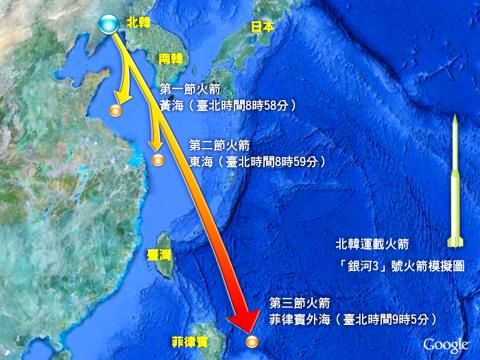The Ministry of National Defense (MND) yesterday for the first time publicly confirmed that its US$1.3 billion long-range early-warning radar (EWR) system in Hsinchu was operational and said it had tracked a highly controversial rocket launch shortly after it blasted off in North Korea.
In a statement, the ministry said it closely monitored the launch and that the rocket’s flight did not pose any threat to national security.
“Our long-range early-warning radar system detected the North Korean rocket flying over waters about 200km east of Taiwan, and that the first and second stages of the rocket crashed into waters off South Korea and the Philippines respectively,” the ministry said in a statement.

Photo: CNA screen grab from Google Maps
Ministry spokesman Major General David Lo (羅紹和) said Chief of General Staff General Lin Chen-yi (林鎮夷) was charged with monitoring the situation at Hengshan Headquarters during the launch, adding that US-made Patriot missiles, domestically built Tien Kung air defense systems and Kidd-class destroyers equipped with surface-to-air missiles monitored the launch and were ready to respond.
This was the first time the ministry mentioned the radar system, which was built by US-based Raytheon Corp, as being operational. To date, the military has revealed few technical details about the radar installation, known as the “Anpang Project,” at Leshan (樂山) in Hsinchu County.
Lo later said that the radar system was formally inaugurated on Tuesday and has been operational since.
The installation’s development began in 1999, when US defense officials stressed the importance of Taiwan having early-warning capabilities to track Chinese missiles.
Following a series of debates in the legislature, a US$800 million request by the ministry was granted in November 2003 to fund one EWR site. In March the following year, a notification to US Congress made provisions for two EWR systems for US$1.8 billion, but in June 2005, Taiwan signed a US$752 million contract with Raytheon for only one radar system, with delivery in 2009, the Congressional Research Service said in its annual report on US arms sales to Taiwan, released last month.
Despite reports alleging that the current administration had abandoned plans to acquire a second EWR system, the decision not to do so was made in 2007, with industry sources saying it may have occurred as early as 2003.
From the onset, the program was plagued by a series of delays and cost overruns, bringing the total bill to about US$1.37 billion after three requests for additional funding.
Critics of the program have said Taiwan has paid far more than other US allies for such capabilities and accused Washington of using the EWR as a “money pit.”
Described as the most powerful EWR installation on the face of the planet, Taiwan’s radar can simultaneously track as many as 1,000 airborne targets the size of a golf ball within a range of 3,000km. The system can also track aircraft and may have the ability to monitor targets at sea, though there are doubts that the satellite-tracking is active.
The radar’s reach will give Taiwan a six-minute warning of a missile launch by China. Although defense officials have refused to confirm this publicly, Taiwan will likely share some of the data acquired through the radar with US forces based in the Pacific.
A spokesman for President Ma Ying-jeou (馬英九) quoted him as saying that Pyongyang’s launch was “unwise” and created regional tensions.
The Democratic Progressive Party (DPP) also reacted.
“The DPP staunchly opposes any provocative act that threatens regional security,” DPP Chairman Su Tseng-chang (蘇貞昌) said.
Su added that, unlike the US, South Korea and Japan, the Ma administration had failed to make sufficient preparations nor responded instantly “with the rocket already at the front door.”
“[The Ma administration] acted like this had nothing to do with Taiwan,” Su said.
Additional reporting by Rich Chang and Chris Wang

A car bomb killed a senior Russian general in southern Moscow yesterday morning, the latest high-profile army figure to be blown up in a blast that came just hours after Russian and Ukrainian delegates held separate talks in Miami on a plan to end the war. Kyiv has not commented on the incident, but Russian investigators said they were probing whether the blast was “linked” to “Ukrainian special forces.” The attack was similar to other assassinations of generals and pro-war figures that have either been claimed, or are widely believed to have been orchestrated, by Ukraine. Russian Lieutenant General Fanil Sarvarov, 56, head

SAFETY FIRST: Double the number of police were deployed at the Taipei Marathon, while other cities released plans to bolster public event safety Authorities across Taiwan have stepped up security measures ahead of Christmas and New Year events, following a knife and smoke bomb attack in Taipei on Friday that left four people dead and 11 injured. In a bid to prevent potential copycat incidents, police deployments have been expanded for large gatherings, transport hubs, and other crowded public spaces, according to official statements from police and city authorities. Taipei Mayor Chiang Wan-an (蔣萬安) said the city has “comprehensively raised security readiness” in crowded areas, increased police deployments with armed officers, and intensified patrols during weekends and nighttime hours. For large-scale events, security checkpoints and explosives

‘POLITICAL GAME’: DPP lawmakers said the motion would not meet the legislative threshold needed, and accused the KMT and the TPP of trivializing the Constitution The Legislative Yuan yesterday approved a motion to initiate impeachment proceedings against President William Lai (賴清德), saying he had undermined Taiwan’s constitutional order and democracy. The motion was approved 61-50 by lawmakers from the main opposition Chinese Nationalist Party (KMT) and the smaller Taiwan People’s Party (TPP), who together hold a legislative majority. Under the motion, a roll call vote for impeachment would be held on May 19 next year, after various hearings are held and Lai is given the chance to defend himself. The move came after Lai on Monday last week did not promulgate an amendment passed by the legislature that

PENTAGON ASSESSMENT: A US report said that even as China and Russia deepen their partnership, cooperation is hindered by a ‘mutual distrust’ of each other The Chinese People’s Liberation Army (PLA) as of October had doubled the number of ships and airplanes deployed around Taiwan compared with the previous two years, Vice Minister of National Defense Hsu Szu-chien (徐斯儉) said yesterday, a day after the opposition-controlled legislature voted against reviewing the government’s general budget for next year, including a NT$1.25 trillion (US$39.71 billion) special defense spending bill. The legislature’s vote against the Ministry of National Defense’s spending plans was regrettable, as the budget was designed to respond to the developing Chinese military threat, Hsu said on the sidelines of a legislative meeting on the general budget. Defense